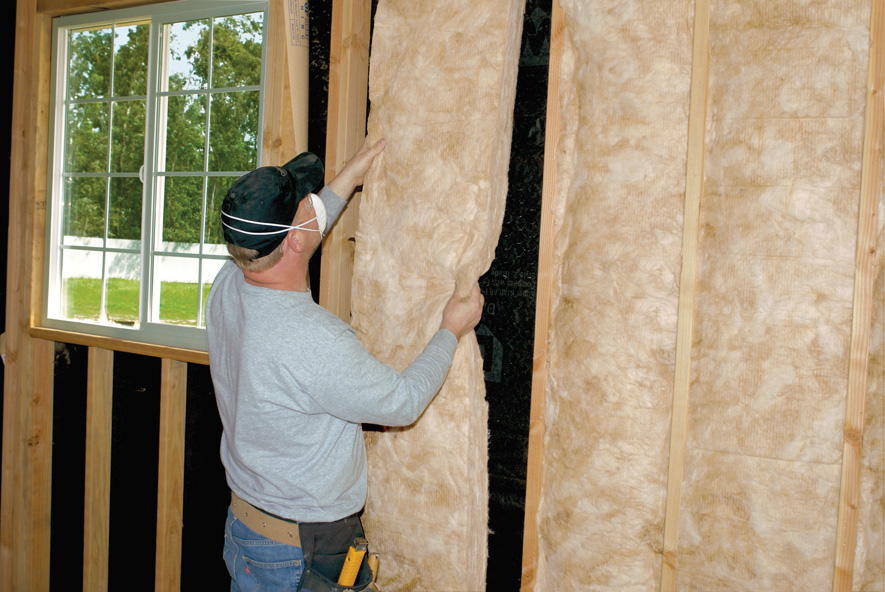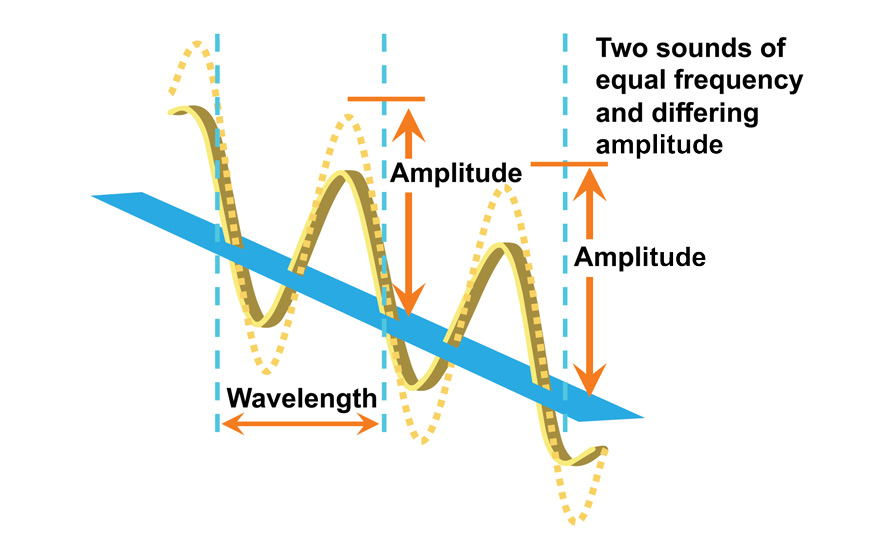Acoustical Control in Buildings
Learning Objectives:
- Analyze the background of acoustics and the fundamentals of sound as they apply to sound transfer between spaces.
- Examine the science and emerging standards for limiting background noise in green schools, hospitals, and other buildings.
- Assess the contribution that good acoustical design makes toward improved indoor environmental quality in green and sustainable building design.
- Identify the elements that make up a holistic approach toward acoustical design and beneficial sound control.
Credits:
Sound is present in all buildings and affects people in a space just as other types of energy, such as heat and light, do. Controlling all aspects of sound entering or leaving a room or building space is the essence of good acoustical design. Unwanted sound that is allowed to enter from outside of a building can be distracting or even harmful to people inside. Sound flowing between rooms or spaces in a building in all directions (i.e. through walls, floors, ceilings, etc.) can create similar negative indoor experiences. All of these aspects of sound in a building are important to a successful design much the same way designing a building to use desirable light while controlling undesirable glare is important. By taking a holistic approach to acoustical design as an integral part of architectural and interior design, a comprehensive, successful result can be achieved. Controlling the transfer of unwanted sound between spaces reduces noise, improves the indoor environment, contributes to sustainable design, and is ultimately good for the people who use the building.

Photo courtesy of CertainTeed Insulation
Sound control in buildings involves attention to details, particularly in light-weight framed walls that use acoustical insulation to achieve desired results.
FUNDAMENTALS OF SOUND
Sound is energy, and like all energy, it radiates outward from a source. It moves the same way that heat energy and light energy do by traveling through air, solids, and other materials. While there are many beneficial sounds that we want to hear as they travel through space, such as speech in a classroom or music at a concert, there are other sounds that we don’t want to hear, which we call noise. This unwanted or interfering sound in building spaces can come from a variety of sources both within and outside of a building, such as outdoor traffic, activity in an adjacent room, or mechanical equipment.
A certain amount of background noise is certainly commonplace and even acceptable. However, excessive background noise can seriously degrade the ability of people to communicate, overshadow preferred sounds, or prevent audible signals from being heard.
The scientific study of sound and noise has not only looked at the physics of sound, but evolved into the field of acoustics, which looks at sound in all its forms. Architectural acoustics in particular is specifically related to the interactions of sound both within and between architectural spaces and the impacts on people in those spaces. As such, a significant body of knowledge is available on how to deal with sound in human environments as part of the field we know as acoustical design.
Sound Generation
Sound can be generated from single or multiple sources but is typically characterized by three characteristics.
- Frequency (Pitch): Sound has been observed to travel in oscillating waves that radiate out from the source. Those waves are measured in terms of the cycle of the sine-shaped wave that oscillates from neutral, down to negative, up to neutral, further up to positive, and finally back to neutral. The time it takes to complete that one cycle of a sound wave is measured in hertz (Hz). One Hz is equal to a frequency of one cycle per second. The human ear can typically hear frequencies or sound “pitch” between about 20 Hz (very low-pitched, bass sounds) up to around 20,000 Hz (very high-pitched, piercing sounds) if the person is fairly young; older adults may hear frequencies up to about 15,000 Hz. Sound exists above and below this range, but our ears don’t hear it, unlike some animals, such as dogs or bats, that do indeed hear very high-pitched sounds (over 20,000 Hz) or elephants that can hear lower sounds (below 20 Hz).

Image courtesy of CertainTeed Insulation
Sound is characterized by its frequency (pitch), wavelength, and amplitude (volume).
- Wavelength: The wavelength of a sound wave is the distance between the start and end of a sound wave cycle or the distance between two successive sound wave pressure peaks. Numerically, it is equal to the speed of sound in the material, such as air divided by the frequency of the sound wave. For example, the wavelength of a 100 Hz tone at room temperature is 1,130 feet/second (the speed of sound in air) divided by 100 Hz (a fairly low-pitched sound), which is equal to a wavelength of 11.3 feet. By comparison, dividing the speed of sound by a much higher pitch of say 10,000 Hz would produce a much shorter wavelength of .113 feet or a little more than an inch.
- Amplitude (Loudness): The amplitude of a sound wave is visually its height from bottom to top, but is in fact indicative of the strength of the energy in that wave. It is measured in decibels (dB), such that the higher the dB rating, the more energy, and hence the louder the sound that we hear. The common range begins at 0 dB (threshold of hearing) to around 130 dB (threshold of pain), with human speech being in the middle around 50 to 65 dB. The most widely used sound level filter is the A scale, expressed as dBA. Using this filter, a sound level meter is less sensitive to very high and very low frequencies.
Sound waves can travel through any media, such as air, water, wood, masonry, metal, etc. Depending on the media through which it travels, sound is either considered airborne or structure-borne. Airborne sound radiates from a source and travels through the air. The sound of traffic passing our homes, the sound of music or voices from the next room or office, the noise from low flying aircraft—all travel to our ears as airborne sound. Structure-borne sound travels through solid materials usually in direct mechanical contact with the sound source or from an impact on that material. Examples are footsteps or objects falling on the floor upstairs, a knock at the door, or vibration from loud speakers on the floor. All structure-borne sound must eventually become airborne sound in order for us to hear it. We can only feel structure-borne sound as vibrations in a material. In most noise control situations, both airborne and structure-borne sound must be considered.
Sound Transmission
When sound travels through air and strikes a surface, such as a wall, floor, or ceiling, it behaves like other energy. Some of the sound energy is reflected back off of the surface, some is absorbed into the material or construction assembly, and some is transmitted directly through it. This is directly akin to light, which can be reflected off a glossy surface, absorbed into a dark surface, or transmitted through a translucent material. Similarly, different amounts of sound energy can be reflected, absorbed, or transmitted when striking different surfaces, materials, and assemblies in buildings. The following is a summary of terms and measures relating to principles of controlling sound transmission between spaces.
- Transmission Loss (TL) is a fundamental measurement of the ability of a material or building assembly to block or reduce the amount of sound passing through it. It is measured in decibels at different frequencies to determine how much sound transmission is lost at each measured frequency. Generally speaking, a TL of 10 means that the sound is 10 dB quieter on the listening side compared to the sound-originating side.
- Sound Transmission Class (STC) is determined by ASTM E90 test methods to measure airborne transmission loss specifically in interior walls and ceiling/floor assemblies. A higher STC rating means that more airborne sound is blocked by the component or assembly. Lower STC ratings mean that more sound passes through the components or assemblies, adding to the background noise level in the space. It should be noted that, contrary to the popular notion that sound passes through a structure, such is not the case. Sound generated on one side of a wall will energize the wall structure and set it in motion, much like a diaphragm. The wall itself becomes the transmitter of the sound energy, which can be heard on the opposite side of the wall by the listener. Hence, the ASTM test methods used to determine STC ratings have focused on this direct transmission process, although this testing has changed over the years, meaning that STC results posted before 1999 may not produce the same results today.

Images courtesy of CertainTeed Insulation
The sound transmission class (STC) is a measure of airborne sound transmission loss, while the impact insulation class (IIC) is a measure of structure-borne sound transmission loss.
Currently, the STC number is derived from sound values tested at 16 standard frequencies from 125 Hz to 4,000 Hz. These transmission-loss values are then plotted on a sound pressure level graph, and the resulting curve is compared to a standard reference contour. Acoustical engineers fit these values to the appropriate transmission loss curve to determine a final STC rating. The STC measurement is accurate for speech sounds but less so for amplified music, mechanical equipment noise, transportation noise, or any sound with substantial low-frequency energy below 125 Hz. Nonetheless, since this is fundamentally a measure of TL, the derived STC number generally reflects how many decibels quieter the receiving side of a wall is compared to the sound-originating side (e.g. STC 45 means a reduction of 45 dbA). In terms of people’s perception of sound, a general rule of thumb is that each 10-point increase in STC value will decrease the perceived noise by one half of the starting point.
- Outdoor Indoor Transmission Class (OITC) is a standard method used to rate the amount of transmission loss in an exterior wall setting, such as determining how much traffic noise an exterior wall can stop. The OITC covers a lower or broader frequency range from 80 Hz to 4,000 Hz, where most aircraft, rail, and vehicular traffic sounds would be found.
- Impact Insulation Class (IIC) is a measure of the ability of a floor-ceiling assembly to absorb or deflect sound from impacts (such as people walking or objects dropping) and keep it from being transmitted to the space below. It is not a measure of airborne sound but rather of structure-borne sound. The IIC rating is determined by ASTM Standard E989: Standard Classification for Determination of Impact Insulation Class (IIC). Test data obtained in accordance with ASTM E492: Standard Test Method for Laboratory Measurement of Impact Sound Transmission Through Floor/Ceiling Assemblies Using the Tapping Machine, is used to determine the IIC rating of a floor.
- Ceiling Attenuation Class (CAC) is a measure for rating the performance of a ceiling system as a barrier to airborne sound transmission through a common plenum between adjacent closed spaces, such as offices. CAC for ceilings is similar to an STC rating for walls, but is specific to suspended ceiling conditions where a dividing wall is constructed only to the ceiling height, thus allowing sound to pass through a plenum space above the ceiling. As an ASTM E1414 tested measurement, it is a ‘two pass’ test in that the sound is looked at as it transmits up through the ceiling in one space, across the ceiling plenum, and back down through the ceiling in an adjacent space. A higher CAC rating means that less sound is transferred between spaces. A ceiling system with a CAC below 25 is considered low performance, whereas one with CAC above 35 is high performance.










